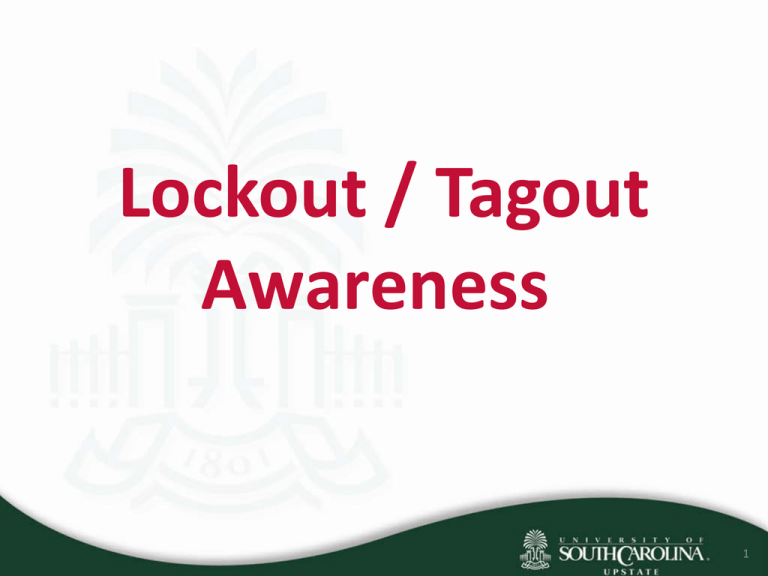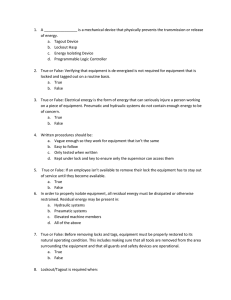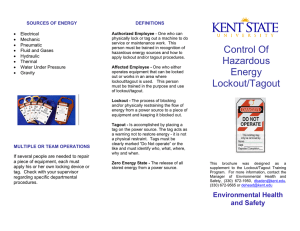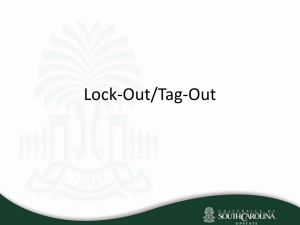Lockout / Tagout Awareness
advertisement

Lockout / Tagout Awareness 1 Introduction • Lockout/Tagout (“LOTO”) is a technique used to prevent energy from being released during the servicing of equipment. This is accomplished by placing locks on energy sources prior to starting work. • People conducting maintenance/repair operations on machinery and equipment are exposed to possible injury from the unexpected start-up of the equipment, or the release of stored energy in the equipment. The purpose of a Lockout/Tagout program is to prevent injury to individuals performing repair and maintenance tasks. Lockout/Tagout • The Lockout/Tagout program at USC Upstate requires the use of specific maintenance safety procedures to shut down, isolate, prevent the release of stored energy, and to bring the equipment back on-line. In addition, employees will receive training to ensure that they fully understand the concepts of lockout/tagout and the methods by which safety procedures are implemented. Useful Definitions • Authorized employee: An employee who actually locks/tags machines or equipment in order to perform servicing or maintenance. Examples of Authorized employees are: electricians, plumbers, energy facility operators, etc. Authorized employees must be trained in the recognition of hazardous energy sources, the type and magnitude of energy sources in their work area, and the procedures that are used for energy isolating and control. • Affected employee: An affected employee is not qualified to lock/tagout a piece of equipment, but uses/operates a machine or piece of equipment which may need maintenance or servicing. An affected employee can also be a person who works in/around an area where equipment may be locked/tagged out. Examples of an Affected employee are: housekeeping staff, grounds staff, roofers, office employees, etc. • Energy source: Any source of electrical, mechanical, hydraulic, pneumatic, chemical, thermal, or other energy. Energy sources are what makes the piece of equipment or machinery run, move or operate. Equipment may have a single energy source, or may have many different sources of energy. • Energized: Machines and equipment are energized when they are connected to an energy source, or they contain residual or stored energy. An example of stored energy could be a steam line. Even though you may have isolated a section of steam line by closing valves, pressure will remain in the line until it is properly bled-off. Useful Definitions • Capable of being locked out: A energy-isolating device must be locked-out if it is available on the piece of equipment you are performing maintenance tasks. An energy-isolating device is considered capable of being locked out if it: • • • Is designed with a hasp or other means of attachment to which a lock can be affixed. Has a locking mechanism built into it. Can be locked without dismantling, rebuilding, or replacing the energy-isolating device or permanently altering its energy control capability. • Lockout: The placement of a lockout device on an energy-isolating device which ensures that equipment being controlled cannot be operated until the lockout device is removed. • Lockout device: examples include locks, chains, blank flanges and bolted slip blinds. Lock out devices are used to hold an energy-isolating device in a safe position and to prevent the start-up of machinery or equipment. Whenever possible a lockout device must be used along with a tagout device. An example of this is when you lockout a electrical disconnect, you must attach the warning tag to the lock shackle and then attach both the lock and tag to the disconnect. Never remove a lockout that does not belong to you. • Tagout device: A tag and a nylon tie that is securely fastened to an energy-isolating device to indicate that the machine cannot be operated until the tagout device is removed. A tag alone will only serve as a warning device - people can easily remove tags, putting you at risk. Never remove a tagout that does not belong to you! Multiple Energy Sources • Depending on the specific piece of equipment you are servicing or maintaining, there may be one source of energy to lockout/tagout, or there could be many sources of energy that must be isolated before beginning maintenance activities. • An example of a single source piece of equipment would be an electrically driven pump motor. • An example of a multi-source piece of equipment would be a large boiler that has gas, electrical, and pneumatic energy sources. • As you can see, it is generally easier to isolate the energy sources leading to single source piece of equipment when compared to a multi-source piece of equipment. Lockout / Tagout Awareness • Persons servicing equipment that could cause injury if energized should place a device or sign like the ones on the right to notify others not to power-on the equipment. 7 Lockout / Tagout Awareness • If equipment or machinery is switched on while someone is working on it, serious injury could occur to that person. 8 Overview If there is a “DO NOT TOUCH” sign or lockout device attached to a piece of equipment, light switch, electrical breaker, etc, then use your head and DON’T TOUCH IT! The maintenance employee’s safety depends on it! 9 • You may now finish this safety training tutorial by completing the OSHA Assessment Quiz.


